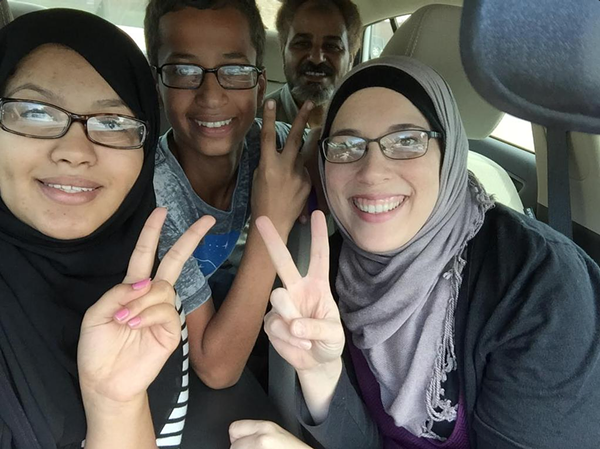I remember a particularly sunny afternoon in South Brunswick, NJ, when my high school had a “bomb threat.” We’d had six already and everyone knew it was just some vagrant scrawling threatening words on the bathroom walls. Still, the school was evacuated. As I gleefully followed my friend out the double doors into the shaded lawn ahead, I walked past a group of tall, white jocks and I heard one declare “Yeah, YOU WOULD BE THE FIRST TO RUN, WOULDN’T YOU? Lookin’ guilty!” I gave them the usual look of contempt but glanced around to see if anything had been said to my aforementioned friend, who was also Muslim and Pakistani – but looked Italian, or maaaybe Lebanese. You guessed it. Nobody even noticed her.
“Ignore them,” she said. I did.
Ignoring them was easy. What wasn’t easy to ignore was the fact that the comments had only been passed at me, the visible Muslim: a hijab-wearing, distinctly brown girl – but nothing was said to the Muslim girl who was white, non-hijabi and often mistaken for Italian. Coincidence? I think not.
I know this because the following day, a handful of brown Arab boys were suspended for getting into a fistfight with some kids who called them “terrorists.” But again, the Muslim boy named Adam who looked Irish? Nobody called him a “terrorist,” and I bet nobody ever has. In the meantime, “terrorist” was added to the long list of names I’d been called, and my friend went on to simply being called “Italian.”
So, when people rush to claim that Ahmed Mohamed, the adorable 9th grader who brought a homemade clock to school, was arrested because of his faith and only his faith, I beg to differ. When people claim his blackness (not brownness) had nothing to do with it, it simply is not the case. The Muslim faith does not exist in a vacuum. Although we, as Muslims, may claim to be “color-blind” (though I inherently disagree, actually, hate, this concept), the rest of the world does not see Muslims in a color-blind fashion. The majority of Americans do not think of Irish-looking Adam from Turkey as a typical “Muslim.” They think of Ahmed from Sudan, whose skin so starkly differs from their own, as “Muslim.” They think of him as foreign. They think of him as a threat. They think of the white Muslim as an exception, or a mistake. People who “pass” as non-Muslim might not be subject to the same amount of bigotry as Ahmed was. The simple reason is that it’s harder to be a bigot when the person looks exactly like you- named Ahmed, or not.
There is a very distinct reason that one of the policeman saw Ahmed and said, “Yep, that’s who I thought it was”. The reason is not just that his name is Ahmed. The reason is that he “looked” like an Ahmed. He “looked” like a Muslim.
Ask any white-skinned Muslim, and they’ll probably tell you. They hear it all the time. “Oh but you don’t LOOK Muslim!” Now, there is a long discussion to be had about what a Muslim looks like. First, we have to address this issue within our own community, then tackle how it appears in the media. But that’s not my point.
My point is that we cannot pretend that Ahmed would definitely have been arrested if he was a white Muslim who could “pass” for non-Muslim. There is no doubt that the color of his skin prejudiced the teachers and the police against him. So, while his faith and name were certainly the driving force, do not erase his blackness from his identity. Do not delude yourself into thinking that it was only his faith and name that got him arrested. It was also the “Muslim”ness of his skin.
[separator type=”thin”]
Hafsa Ahmad is a writer and Associate Editor at Altmuslimah. She is a graduate of Middlebury College, where she studied International Politics and Economics. Hafsa is currently writing and residing in Lahore, Pakistan.
(Photo Credit: Alia Salem on Twitter!)


